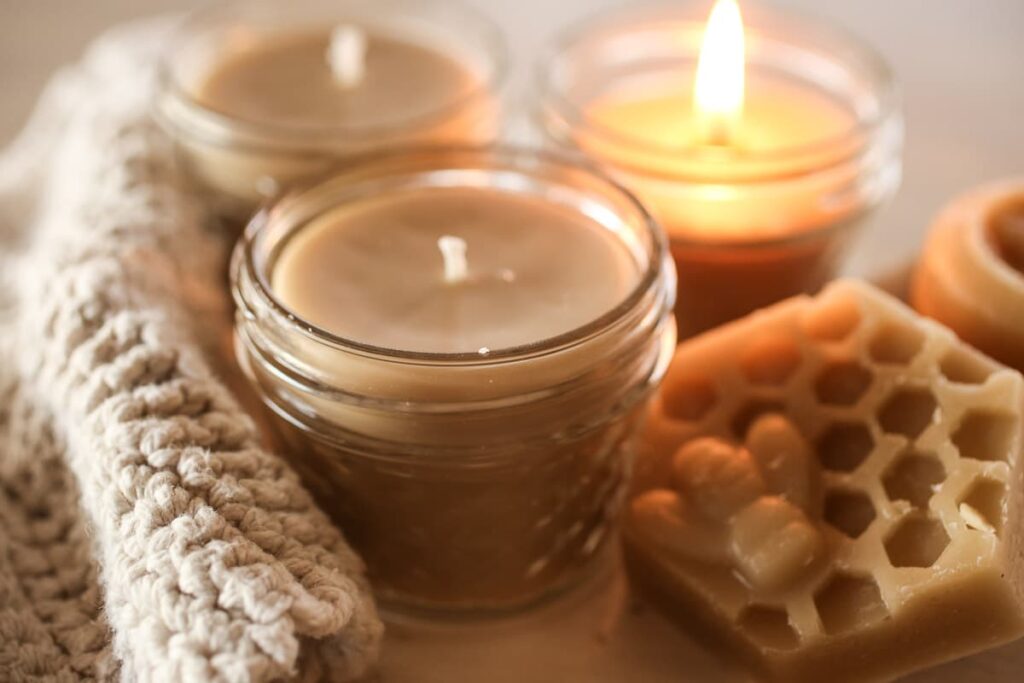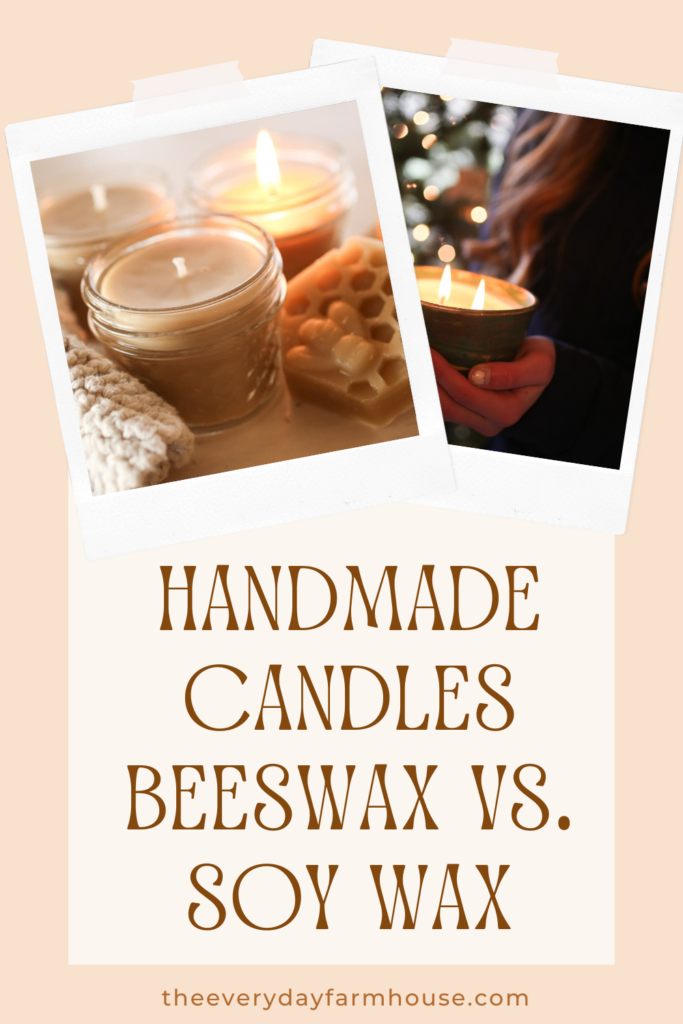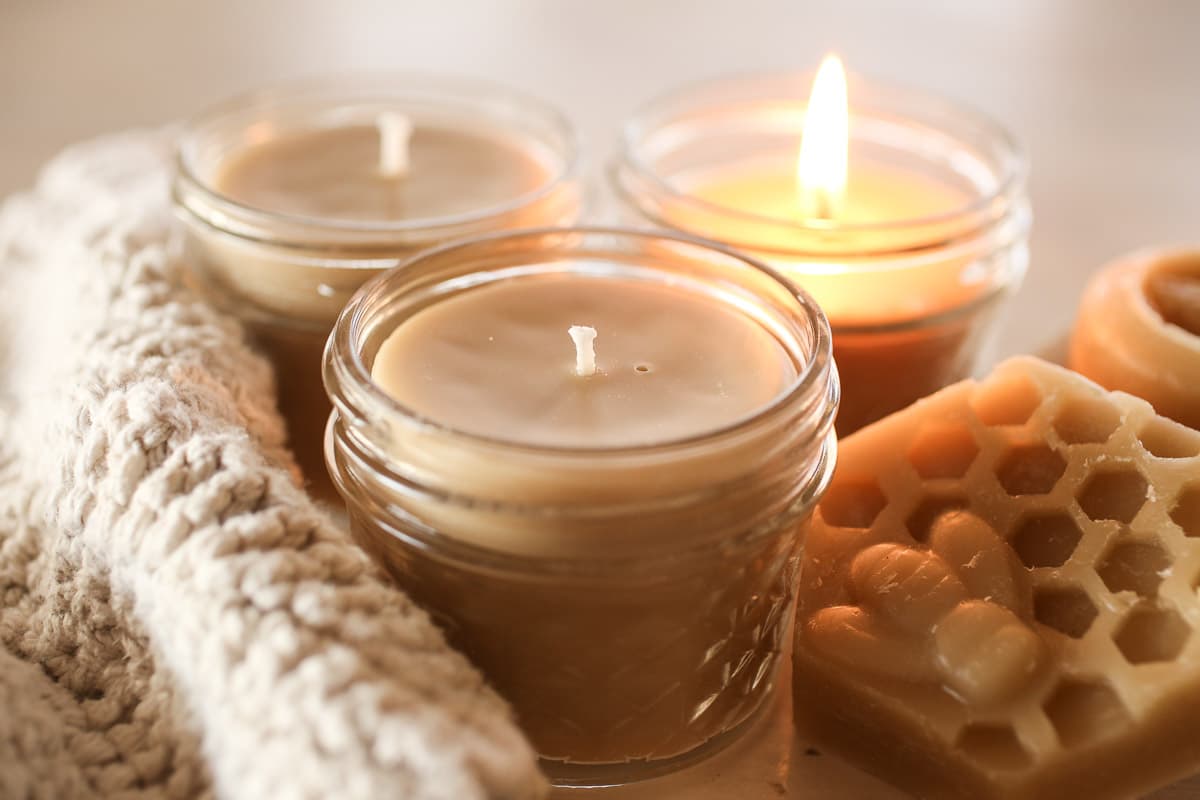Beeswax vs. Soy Candles: Illuminating the Differences
Beeswax vs. Soy Candles, what is the difference, and which one is better? In the search for eco-friendly and natural alternatives to traditional paraffin candles, beeswax, and soy candles have gained popularity. Today, we’ll explore the unique characteristics of beeswax candles and soy candles, shedding light on the differences that make each a distinctive choice for candle enthusiasts and candle makers.
This post contains affiliate links


Candle Making
If you are interested in candle making, I have tutorials on how to make and pour beeswax candles, soy wax candles, lard candles, and also a tutorial on how to hand dip beeswax candles. All of them are similar in approach with different benefits.
Beeswax candles are lovely and timeless, they have the slightest aroma of honey, however, you can also add fragrance oil or essential oils to scent them however you like. The slight fragrance doesn’t seem to interfere with the oils you add.
Soy wax doesn’t have a fragrance, so you can also add any essential or fragrance oils that you like.
Both Beeswax and Soy Wax can be purchased easily and affordably. Both are available in pellets making either one easy to work with.
Below is a breakdown of some more of the features of beeswax vs soy wax candles.
How is Soy Wax Made?
Soy wax is derived from soybean oil. To produce wax, harvested soybeans are:
- Cleaned
- Cracked
- De-hulled
- Rolled into flakes
Next, the oil is extracted from these flakes using solvents or mechanical pressing. Usually, the soybean oil is hydrogenated to change its properties. This process involves adding hydrogen to the oil under high pressure and temperature, which can make the oil more solid at room temperature. the hydrogenation process, fatty acids in the oil become saturated, which alters the melting point of the oil and makes it solid at room temperature. Soy wax is available in flakes or pellets.
How is Beeswax Rendered?
Rendering beeswax is the process of melting and purifying beeswax to remove impurities and debris, leaving behind a clean, usable wax. Here’s a general overview of how beeswax is rendered:
- Harvesting: Beeswax is harvested from beehives. It is usually obtained by removing the wax cappings from honeycomb cells.
- Melting: The harvested beeswax is placed in a heat-resistant container and melted using gentle heat.
- Filtering: While the wax is still in its liquid state, it is filtered through a fine mesh or cheesecloth to remove any debris, such as bee parts, dirt, or leftover honey.
- Cooling and Solidifying: Once the wax has been filtered, it is allowed to cool and solidify. This can be done in molds to create blocks of beeswax or left as a sheet to be further processed.
- Final Processing (optional): Depending on the desired end product, the beeswax may undergo further processing, such as bleaching or refining, to improve its color or purity.
Beeswax Candles:

- Natural Origin: Beeswax candles are derived from the honeycomb of bees, making them a natural and sustainable choice. The process of harvesting beeswax is eco-friendly, as it doesn’t involve the use of harmful chemicals.
- Clean Burn: One of the standout features of beeswax candles is their clean burn. They produce little to no soot, making them ideal for indoor use. This clean-burning quality is one of the biggest appeals of beeswax candles.
- Hypoallergenic: Beeswax candles are hypoallergenic, making them great for people with allergies or sensitivities to artificial fragrances. The subtle honey scent emitted during burning adds a pleasant aroma without overpowering.
- Extended Burn Time: Beeswax candles are renowned for their extended burn time. Due to their dense composition, they tend to burn more slowly than many other candle types, providing a longer-lasting burn. I have a tutorial for making beeswax candles where you add a bit of coconut oil to make them burn more evenly and longer as well.
Soy Candles:

- Renewable Source: Soy candles are crafted from soybean wax, a renewable resource. The cultivation of soybeans has a lower environmental impact compared to the extraction of paraffin, making soy candles an eco-conscious choice. There is still hexane (a petroleum solvent) used in the extraction process. You will need to do your own research on whether or not the processing aligns with your values.
- Biodegradable: Soy candles are biodegradable, meaning they break down naturally without leaving harmful residues. This appeals to people concerned with environmental impacts.
- Versatility: Since Soy has no fragrance at all, this allows for a little more versatility with fragrances. You can add whatever fragrance you desire.
- Satisfactory Burn Time: While soy candles may not burn as slowly as beeswax candles, they still offer a satisfactory burn time. Factors such as size, fragrance, and wick type can influence the duration of illumination.
- Clean-up: Soy wax is much easier to clean up than beeswax.
In the beeswax candles vs. soy candles debate, the choice ultimately comes down to personal preferences and priorities. Beeswax candles, with their natural origin, clean burn, and extended burn time, appeal to those seeking a traditional and eco-friendly option. I find beeswax to be a more sustainable choice for me. Soybeans are often grown as GMO crops. I choose not to eat genetically modified ingredients and I’m not sure how I feel about using them at all. On the other hand, soy candles are considered a renewable and sustainable resource, mostly if compared to paraffin. Overall both beeswax and soy wax are better alternatives to paraffin.



